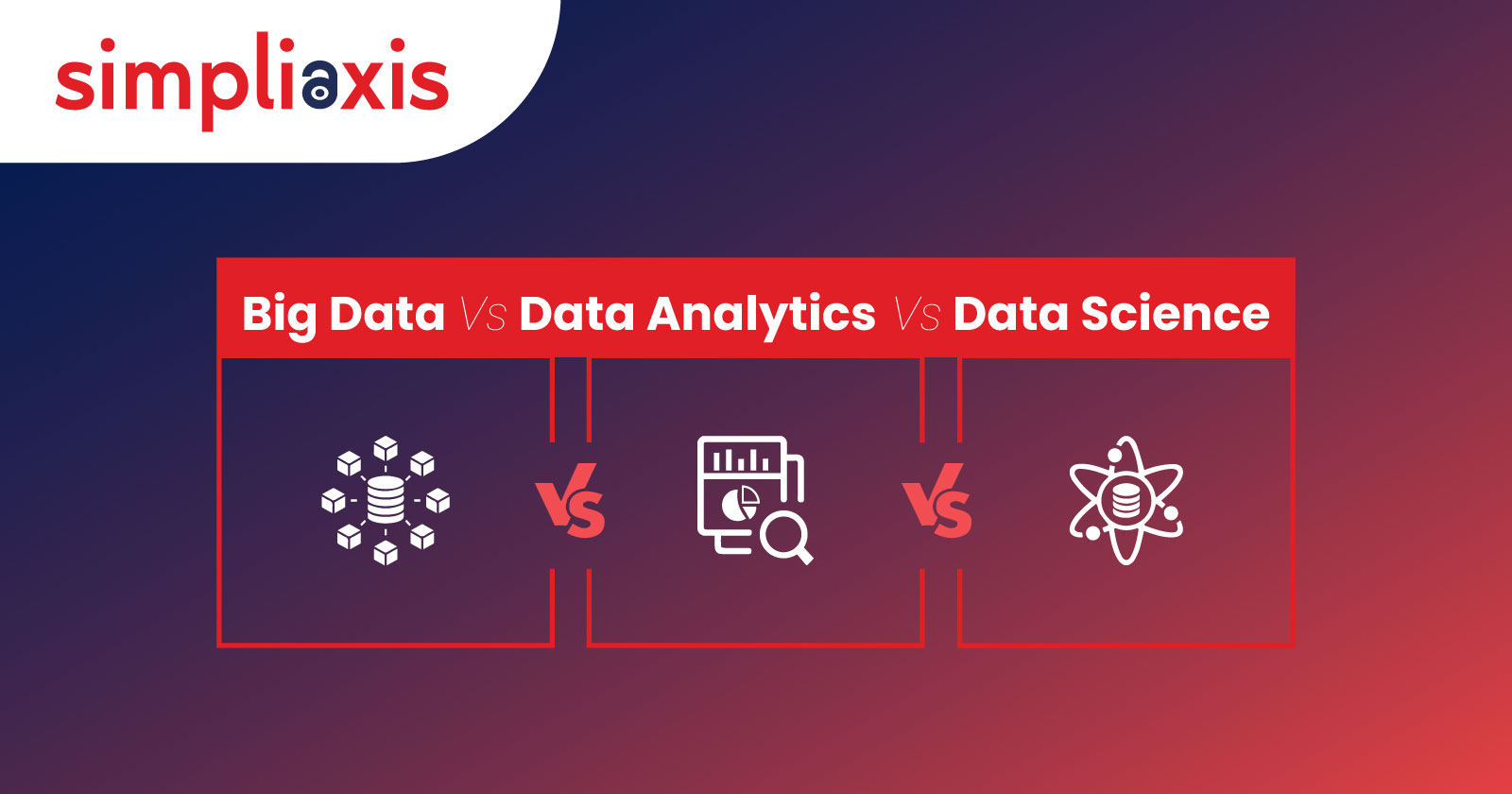Data has become the most valuable and crucial asset for most companies and organizations in the modern digital era. How we live and interact with one another is quickly becoming influenced by data, and businesses worldwide are looking at ways to affect their bottom lines by collecting, organizing, and analyzing this data. Data refers to the assortment of specific pieces of information that have been compiled. The information in the real world may be classified as either structured or unstructured. To start with this blog article on “Data Science vs. Data Analytics vs. Big Data” let’s define the different sorts of data.
Data that have been given a specific arrangement and framework are termed as ‘structured’. Because structured data is consistent and well-defined, it is easy to store and retrieve. Because indexes may be used to store data in its ordered form, it is also possible to simplify looking for data. The second type is known as ‘unstructured’ data. This type is unreliable since no structure, format, or sequence guides its development. When we index data that is not organized, there is a higher risk of mistakes occurring. Understanding and working with unstructured data presents several challenges as a result. Interestingly, we rarely have organized data in the real world but instead, constantly have inconsistent unstructured data. It might be in any form, such as music, video, text, or perhaps something else entirely.
When working with any data-related words, it is essential to understand the many application areas in which these phrases might be used. This article will examine the similarities and differences between Big Data, Data Analytics, and Data Science. Although these three terms are connected and are occasionally used in place of one another, there is a fundamental difference between them. In this article, we will discuss what is the difference between Big Data and Data Science. We will also discuss the theme of Big Data vs data analytics.
Read more:What is Big Data Analytics?
Data Science:
Data Science comprises both unstructured and structured data and the bulk of the processes associated with data, beginning with data generation and continuing through data purification, visualization, mining, and analytics (information). The field of Data Science deals with data in various formats, including unstructured, structured, and semi-structured. It encompasses a variety of processes, the most notable of which are data cleansing, data preparation, and data analysis. It is a combination of statistics, mathematics, programming, and the ability to solve problems; the ability to acquire data in imaginative ways; the capacity to examine things from a fresh viewpoint; and the ability to clean, prepare, and align data are the components that makeup Data Science. This term refers to a collection of methods used to data to draw conclusions and obtain information from it. Data scientists work in close collaboration with business stakeholders to understand their goals and discover how to use data to achieve those goals. They are accountable for tidying up and organizing data, collecting data sets, data mining for trends, algorithm improvement, integrating and storing data, and developing training sets.
Data Analytics
Data Analytics encompasses analyzing raw data to facilitate decision-making within business intelligence industries. Algorithmic procedures will result in operational visions for more complex firm solutions. It has to be analyzed, converted, cleaned, and modeled to be transformed into information. It involves employing an algorithmic or mechanical method to extract insights and investigate several data sets in search of significant correlations. It is utilized in a range of industries. It enables organizations and corporations that specialize in data analytics to make more informed decisions and confirm or reject existing concepts or models. Data analytics places a primary emphasis on inference, which may be defined as the process of generating conclusions based on what the researcher already knows about. Thus, these were the conceptual differences between Big Data and Data Science. We also discussed the conceptual differences between Big Data analytics and Data Science.
In the next section, we will look at the functional and application-based differences to answer the questions: What is the difference between Big Data and Data Science? And, are Big Data and Data Science the same?
Conceptual Differences
‘Big Data’ refers to data collections that are far too extensive to be processed by the currently available software. The initial stage in processing massive datasets, which might be challenging to keep in the memory of a single machine, is to begin with the data in its raw, unaggregated form. This term refers to the enormous amounts of organized and unstructured data that may swamp an organization if it is not managed correctly. The analysis of large amounts of data could provide firms with a means to improve their decision-making and future planning. Big Data may be characterized as information processing methods that demand high volume, high speed, high diversity, and cost-effective, inventive information to grasp better, make choices, and automate activities. Having discussed ‘Big Data’, one is often faced with the question: Are Big Data and Data Science the same? The answer is ‘No’, as we will learn in the next section.
Applications and Benefits of Big Data Analysis
Traffic Management: Cameras along highways, city areas, and vehicle GPS devices collect data on traffic conditions. These data are analyzed, and efficient, time-saving strategies are offered. Using Big Data analysis, an intelligent city traffic system may be created. Fuel economy is another advantage. Big Data has tremendous applications, not only on the ground but also in the air. Air Traffic Management systems like in-flight sensors (propeller, rudder, engine fuel, etc.). These sensors monitor conditions such as flying speed, humidity, and temperature. Analyzing the flight’s machine-generated data makes it possible to estimate when the machine will require replacement/repair. Large-scale data analysis operates a vehicle without human interpretation. In various automotive camera positions, a sensor captures data such as car size, obstacle distance, etc. After analyzing this data, calculations such as the number of angles to spin, speed, and when to stop are performed. These computations facilitate action automation.
Virtual Private Assistants and Internet of Things: Big Data analysis allows virtual personal assistant programs to answer user inquiries. This program keeps track of the user’s location, time, season, search, etc. It responds by analyzing such information. Manufacturers utilize sensors for operational data collection. Analyzing such data makes it possible to predict how long a machine will operate problem-free before requiring maintenance, allowing a company to take preventative measures before the machine breaks down.
Machine Learning and Neural Linguistic Programming: Big Data aids the healthcare industry. Doctors use big data to collect patient experience data and enhance treatment. IoT-enabled devices can identify disease signs and facilitate early treatment. IoT A sensor near a newborn baby monitors heart rate, blood pressure, etc. When a parameter hits a safe threshold, a doctor is notified so that they can take remote action. Online course providers utilize Big Data to locate interested individuals. Online and offline course providers display course advertisements when someone searches for a YouTube tutorial video on a particular topic.
Benefits of data analytics in various industries
Travel, Tourism, and E-Commerce: Data analytics might make shopping more enjoyable by analyzing mobile apps, blogs, and social media data. The data collected from travel websites can provide insight into customers’ preferences. Products can be upsold and cross-sold by connecting existing sales to an increase in subsequent conversions from browsing to buying through individualized bundles and discounts. Data analytics based on social media may also give individualized recommendations for holiday spots.
Gaming Companies: Data analytics makes it easier to collect data, which can then be used to optimize and distribute resources within and between games. In addition to this, gaming companies may better understand their customer’s preferences. Further, Data analytics enables companies to make fairer games and reduce algorithmic biases that creep into such platforms.
Healthcare and Diagnoses: The key challenge hospitals face is providing high-quality medical treatment to a sufficient number of patients in the most time- and cost-effective manner. Data collected by instruments and machines are increasingly being used to monitor and improve patient flow, therapy, and hospital equipment. It is projected that by utilizing software developed by companies specializing in data analytics, there would be a one percent gain in efficiency, which would result in substantial cost savings for healthcare provided all over the world.
Management of Energy Resources: The management of energy, including smart-grid management, energy optimization, energy distribution, and building automation, is facilitated by utilizing data analytics by organizations that provide utility services. The essential duties of this program are managing service interruptions, controlling and monitoring network equipment, and sending out teams. In addition, the program sends out teams. Engineers can use analytics to keep an eye on the network since utilities can include millions of data points into the functioning of the network.
Application of Data Science in Various Domains
Digital advertising: The application of Data Science in digital advertising is becoming increasingly common. It is essential to highlight that most websites, if not all, that rely on advertising as their primary source of revenue display advertisements pertinent to the visitor’s browsing history and activity. Every digital marketing service provider, such as Google AdSense, uses Data Science algorithms and machine learning to personalize the adverts a user sees on their devices. These discussions have recently been affected by the most current privacy law, which has forced several organizations to abandon customization in favor of group-based search behavior. This legislation has caused numerous firms to forgo customization in favor of group-based search behavior.
Efficiency in Internet Search: When a person searches for a term or conducts a query in standard and incognito mode, the search results may display a different image. This is because incognito mode hides the user’s browsing history. This is because a form of filter bubble has been established. Search results are filtered depending on a user’s browsing history and search activity when registered into an account. This behavior is taken into consideration when compiling search results.
Recommendatory Systems: Online streaming services such as Netflix, YouTube, Spotify, and others make recommendations for new content to their users based on the user’s past search history. These systems use sophisticated neural mapping techniques and machine learning to forecast the user’s content consumption and make recommendations based on that forecast. Several other websites that are comparable are using and developing many algorithms to produce efficient recommendatory systems. These kinds of websites frequently accommodate the preferences of the user.
Also check:Data Scientist Roles and Responsibilities
Conclusion
Considering the distinctions between Big Data, Data Science, and data analytics presented earlier, it is essential to emphasize that Big Data encompasses Data Science. In addition, data analytics has its own unique set of processes and tasks, all of which are essential to the operation of businesses in the modern day. Data Science is an integral component in a wide variety of different applications. Big Data is harnessed in Data Science to perform predictive analysis to get important insights, which are then utilized in making intelligent judgments. Consequently, Data Science is being merged into Big Data rather than being incorporated into Data Science.
Simpliaxis offers Data Science Certification Training and Big Data Analytics Training to equip professionals with the skills needed to excel in these fields. Join our courses to master the techniques and tools essential for leveraging Big Data and Data Science in your career.













 +1-361-998-9988
+1-361-998-9988


